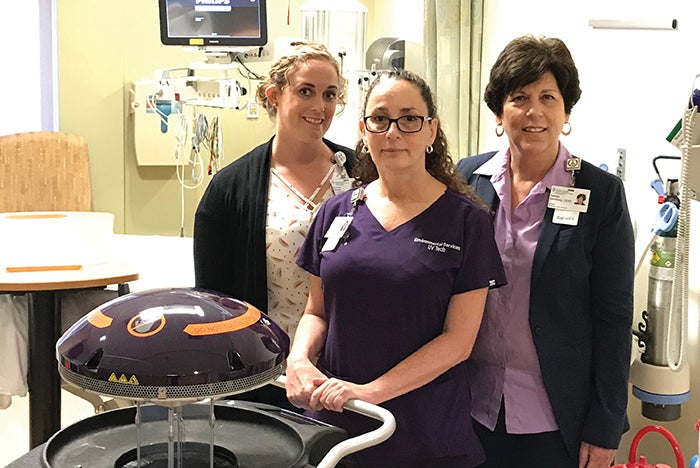UV robot joins hospital’s EVS team

From left: Andrea Brown, EVS training supervisor; Patricia Mullins, UV technician; and Debbie Sandberg, EVS director.
Image Courtesy of Sutter Medical Center
Sutter Medical Center, Sacramento, Calif., the flagship location of the Sutter Health network, has served its community since 1923. The 523-bed comprehensive adult, children’s and women’s hospital provides several services and includes two acute-care facilities — the Ose Adams Medical Pavilion and the Anderson Lucchetti Women’s and Children’s Center — connected by a three-story spanning structure. The downtown hospital says that its mission is to enhance the health and well-being of patients in the communities it serves, which includes supportive role and nonclinical functions.
Debbie Sandberg, CESE, is the director of environmental services (EVS) for Sutter Health where she is responsible for its Sacramento-area facilities. She says the medical center has maintained infection rates lower than the state and national averages, but realizing the trend in antibiotic-resistant organisms, sought a product that would help it keep patients safe by preventing health care-associated infections (HAIs).
“Infection prevention is a multifactorial program,” Sandberg says. “The microorganisms that cause infections are becoming resistant to cleaning chemicals and antibiotics.”
Sandberg says that factors such as hand hygiene and close communication with the teams’ infection preventionist and nursing staff are all crucial factors in its multipronged plan. In 2017, it added another piece to its process when it purchased a LightStrike Germ-Zapping Robot from Xenex Disinfection Systems.
The ultraviolet (UV) disinfection system uses a patented pulsed xenon light technology for fast and thorough disinfection. Sandberg says the medical center chose the product after reading peer-reviewed, published research from hospitals that achieved infection-rate reductions after using pulsed xenon UV disinfection robots. The EVS team named the robot Xhaiden 1, an Indian name that means “cleansing beam of light.”
“EVS professionals are focused on high-touch surfaces where diseases can be easily transmitted, like doorknobs, tray tables, sinks and bedrails,” Sandberg says. “Xhaiden helps us disinfect the room by destroying any microscopic pathogens that may have been left behind on high-touch surfaces.”
Recognizing the facility could only disinfect a certain number of rooms per day with one robot, Sandberg developed a targeted approach for treating rooms in four different medical units to maximize the effectiveness of the program. The hospital has a dedicated UV technician who disinfects all discharges in the hospital’s bone marrow transplant (BMT) unit. Patients in this unit typically stay for 30 days for treatment, so the LightStrike robot is also used to disinfect every patient’s bathroom and support rooms weekly. The UV tech disinfects the pediatric intensive care unit playroom daily and any Clostridium difficile patient discharges (patient room and bathroom).
The facility currently averages disinfecting 13 rooms per day plus disinfecting surgical suites in the evening after the procedures are complete.
The medical center has seen a reduction in infection rates since it began using the robot in its BMT unit. It plans to add more robots in the near future to increase the number of rooms being disinfected and expand to the emergency department. Sandberg says they will name the units Xhaiden 2, Xhaiden 3 and so on.
“HAIs may cost $20,000 to $50,000 per infection, so the LightStrike robot paid for itself in a very short period of time,” Sandberg says.




